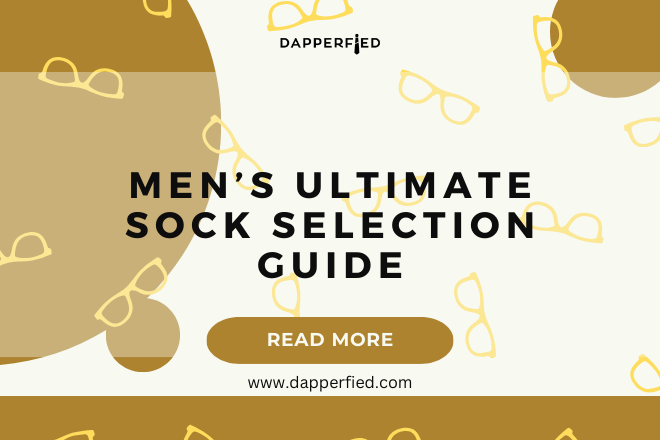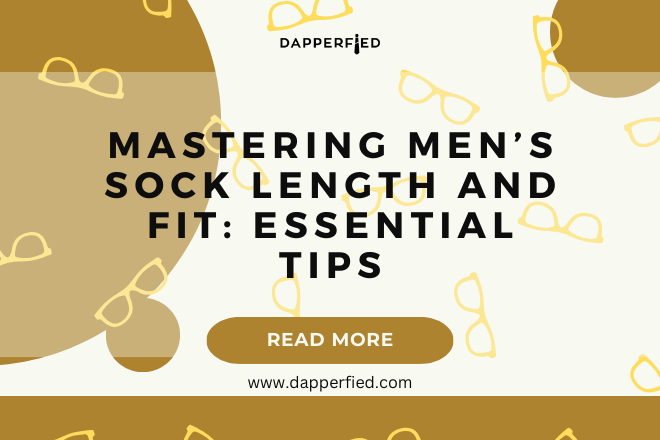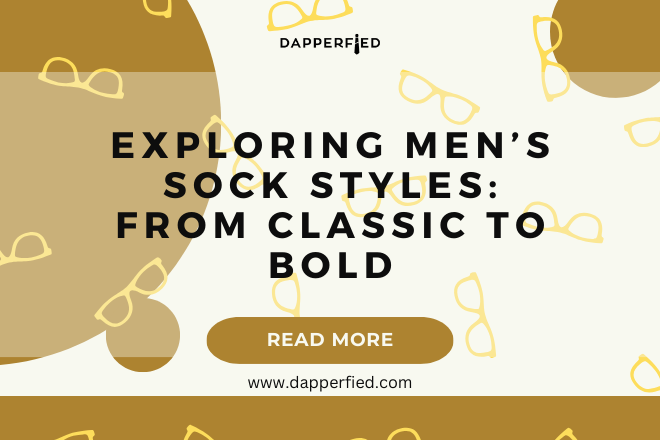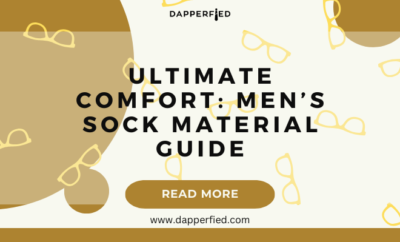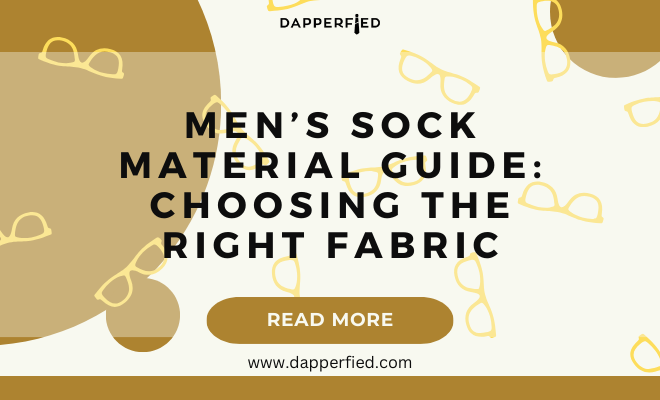
Men's Style
Men’s Sock Material Guide: Choosing the Right Fabric
Selecting appropriate socks requires careful consideration of materials, as different fabrics offer distinct advantages and address various requirements. Familiarity with the properties of each material enables informed decision-making, ensuring optimal foot comfort and support throughout daily activities. Options range from traditional cotton and insulating wool to environmentally friendly bamboo, high-performance synthetic fibers, and versatile fabric blends.
Each material possesses unique characteristics, including breathability, moisture management, durability, and odor control. A comprehensive understanding of sock materials facilitates the selection of suitable footwear for specific lifestyles and activities.
Key Takeaways
- Different sock materials offer various benefits such as warmth, durability, eco-friendliness, and performance-driven features.
- Cotton is a classic choice for socks due to its breathability and comfort, making it suitable for everyday wear.
- Wool socks are warm, durable, and moisture-wicking, making them ideal for outdoor activities and cold weather.
- Bamboo socks are eco-friendly, odor-resistant, and have natural moisture-wicking properties, making them a great choice for those with sensitive skin.
- Synthetic fabrics like nylon and polyester offer performance-driven features such as moisture-wicking, durability, and quick-drying capabilities, making them suitable for athletic activities.
Cotton: The Classic Choice
Comfort and Versatility
Cotton socks are ideal for everyday wear and casual activities. They are gentle on the skin and provide a comfortable fit, making them perfect for daily use.
Drawbacks of Cotton Socks
However, cotton socks have some downsides. One major drawback is their moisture-absorbing properties, which can lead to dampness and discomfort, especially during intense physical activities. Additionally, cotton socks may not be as durable as other materials and can lose their shape over time.
Why People Still Prefer Cotton Socks
Despite these drawbacks, many people still prefer cotton socks for their everyday comfort and versatility. They offer a unique combination of softness, breathability, and comfort that is hard to find in other materials.
Wool: The Warm and Durable Option
Wool is a popular choice for socks, especially in colder climates, due to its exceptional warmth and durability. It is a natural insulator that retains heat, making it ideal for keeping feet warm in cold weather. Wool socks are also known for their moisture-wicking properties, which help to keep feet dry and comfortable.
Additionally, wool is naturally odor-resistant, making it a great choice for outdoor activities and long hours of wear. While wool socks may be pricier than other materials, they are an excellent investment due to their longevity and performance. However, some people may find wool to be itchy or too warm for everyday wear, so it’s essential to consider personal preferences and sensitivities when choosing wool socks.
Wool is a popular choice for socks, especially in colder climates, due to its exceptional warmth and durability. It is a natural insulator that retains heat, making it ideal for keeping feet warm in cold weather. Wool socks are also known for their moisture-wicking properties, which help to keep feet dry and comfortable.
Additionally, wool is naturally odor-resistant, making it a great choice for outdoor activities and long hours of wear. While wool socks may be pricier than other materials, they are an excellent investment due to their longevity and performance. However, some people may find wool to be itchy or too warm for everyday wear, so it’s essential to consider personal preferences and sensitivities when choosing wool socks.
Bamboo: The Eco-Friendly and Odor-Resistant Material
| Properties of Bamboo | Benefits |
|---|---|
| Eco-Friendly | Bamboo is a highly renewable resource and grows much faster than trees |
| Odor-Resistant | Bamboo has natural antimicrobial properties, making it resistant to odors |
| Durability | Bamboo is strong and durable, making it suitable for various applications |
| Softness | Bamboo fabric is soft and comfortable to wear |
| Biodegradable | Bamboo products are biodegradable, reducing environmental impact |
Bamboo is a sustainable and eco-friendly material that has gained popularity in the sock industry due to its unique properties. Bamboo socks are incredibly soft, making them gentle on the skin and suitable for those with sensitive feet. They are also naturally hypoallergenic and antibacterial, making them an excellent choice for individuals prone to skin irritations or allergies.
Bamboo fibers have excellent moisture-wicking abilities, keeping feet dry and comfortable throughout the day. Additionally, bamboo is odor-resistant, making it an ideal choice for active individuals or those who spend long hours on their feet. Furthermore, bamboo is a renewable resource that requires minimal water and no pesticides to grow, making it an environmentally friendly option for conscious consumers.
Bamboo is a sustainable and eco-friendly material that has gained popularity in the sock industry due to its unique properties. Bamboo socks are incredibly soft, making them gentle on the skin and suitable for those with sensitive feet. They are also naturally hypoallergenic and antibacterial, making them an excellent choice for individuals prone to skin irritations or allergies.
Bamboo fibers have excellent moisture-wicking abilities, keeping feet dry and comfortable throughout the day. Additionally, bamboo is odor-resistant, making it an ideal choice for active individuals or those who spend long hours on their feet. Furthermore, bamboo is a renewable resource that requires minimal water and no pesticides to grow, making it an environmentally friendly option for conscious consumers.

Synthetic Fabrics: The Performance-Driven Choice
Synthetic fabrics such as polyester, nylon, and spandex are popular choices for athletic and performance-driven socks due to their advanced features. These materials are known for their durability, flexibility, and moisture-wicking abilities, making them ideal for high-intensity activities and sports. Synthetic socks are designed to provide support, cushioning, and breathability while maintaining their shape and performance over time.
They are also quick-drying and resistant to shrinking or stretching out of shape. Additionally, synthetic fabrics offer a wide range of designs and colors, making them a versatile choice for individuals looking for specific performance features combined with style. Synthetic fabrics such as polyester, nylon, and spandex are popular choices for athletic and performance-driven socks due to their advanced features.
These materials are known for their durability, flexibility, and moisture-wicking abilities, making them ideal for high-intensity activities and sports. Synthetic socks are designed to provide support, cushioning, and breathability while maintaining their shape and performance over time. They are also quick-drying and resistant to shrinking or stretching out of shape.
Additionally, synthetic fabrics offer a wide range of designs and colors, making them a versatile choice for individuals looking for specific performance features combined with style.
Blends: Finding the Best of Both Worlds
Benefits of Blended Socks
Common blends include cotton-polyester, wool-nylon, or bamboo-spandex combinations that offer the benefits of each material while minimizing their drawbacks. For example, cotton-polyester blends provide the softness of cotton with the durability of polyester, making them suitable for everyday wear with added longevity.
Material Combinations for Specific Needs
Wool-nylon blends offer the warmth of wool with the strength of nylon, creating durable and insulating socks ideal for outdoor activities. Bamboo-spandex blends combine the softness of bamboo with the stretchiness of spandex for a comfortable and flexible fit.
Versatility of Blended Socks
Blended socks cater to a wide range of preferences and needs by combining the best features of different materials into one versatile product.
Considerations for Choosing the Right Sock Material
When choosing the right sock material, there are several factors to consider based on your lifestyle, activities, preferences, and needs. Firstly, consider the climate you live in or the activities you engage in regularly. If you live in a colder climate or enjoy outdoor activities in winter, wool or wool-blend socks may be the best choice for warmth and insulation.
For individuals with sensitive skin or allergies, bamboo or bamboo-blend socks offer hypoallergenic and antibacterial properties that can provide comfort and peace of mind. If you lead an active lifestyle or engage in sports regularly, synthetic fabric socks with moisture-wicking abilities may be the most suitable option to keep your feet dry and supported during high-intensity activities. Another consideration when choosing sock material is breathability and moisture-wicking abilities.

If you tend to sweat heavily or spend long hours on your feet, look for materials such as bamboo or synthetic fabrics that offer excellent moisture management to keep your feet dry and comfortable throughout the day. Additionally, consider the level of cushioning or support you need from your socks based on your daily activities or footwear choices. Some materials offer more padding or compression features that can provide extra support for your feet during long periods of standing or walking.
In conclusion, understanding the different sock materials is essential for finding the perfect pair to suit your lifestyle and needs. Whether you prefer the classic comfort of cotton, the warmth of wool, the eco-friendly properties of bamboo, the performance-driven features of synthetic fabrics, or the versatility of blended materials – there is a perfect sock material out there for everyone. By considering factors such as climate, activities, breathability, moisture-wicking abilities, support level needed, and personal preferences when choosing sock material can help you make an informed decision that ensures your feet stay comfortable and supported throughout the day.
If you’re interested in unique men’s clothing, you should check out this article on unique men’s clothing from Dapperfied. It’s a great read for anyone looking to expand their wardrobe with some one-of-a-kind pieces. And while you’re at it, don’t forget to brush up on your knowledge of antique pocket watches with this article on antique pocket watches. And if you’re in the market for some new jeans, be sure to check out this guide on cheap men’s jeans for some great options that won’t break the bank.
FAQs
What are the most common materials used for men’s socks?
The most common materials used for men’s socks are cotton, wool, bamboo, and synthetic fibers such as polyester and nylon.
What are the benefits of cotton socks?
Cotton socks are breathable, soft, and absorbent, making them a popular choice for everyday wear. They are also easy to care for and come in a wide range of styles and colors.
What are the benefits of wool socks?
Wool socks are known for their warmth and moisture-wicking properties, making them ideal for cold weather and outdoor activities. They are also naturally odor-resistant and durable.
What are the benefits of bamboo socks?
Bamboo socks are eco-friendly, hypoallergenic, and have natural antibacterial properties. They are also soft, breathable, and moisture-wicking, making them a comfortable choice for all-day wear.
What are the benefits of synthetic fiber socks?
Synthetic fiber socks, such as polyester and nylon, are known for their durability, moisture-wicking properties, and quick-drying abilities. They are often used in athletic and performance socks.
How should men care for their socks based on the material?
Cotton socks can be machine washed and dried, while wool and bamboo socks should be washed in cold water and air-dried to maintain their shape and softness. Synthetic fiber socks can typically be machine washed and dried as well.


